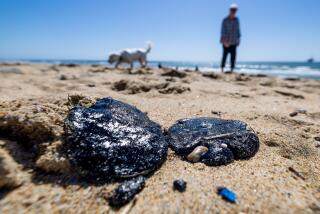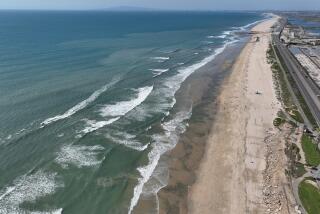BP to employ risky tactic
- Share via
LOS ANGELES AND NEW ORLEANS — BP’s plan to sever a leaking pipe as part of an effort to cap its runaway well in the Gulf of Mexico could increase flow by as much as 20%, and the oil giant has no remedy to stop up the well until August, Obama administration and company officials said Sunday.
The risky maneuver, part of an attempt to contain the gusher and divert the oil through a pipe to the surface, could begin Monday or Tuesday.
Administration and BP officials on Sunday sought to shift attention from last week’s failed attempt to choke the well by focusing on expectations that a new cap could divert much of the leaking oil from the fragile ecosystem of the gulf.
But behind those assurances was the frank admission that the disaster response has fallen back to containment and surface cleanup, not closure, until a relief well reaches the gushing well bore in August and enables engineers to install cement plugs.
“We’re now going to move into a situation where they’re going to attempt to control the oil that’s coming out, move it to a vessel, take it onshore,” White House energy advisor Carol Browner told NBC’s “Meet the Press.” “Obviously that’s not the preferred scenario. We always knew that the relief well was the permanent way to close this.... Now we move to the third option, which is to contain it.”
Browner and BP Managing Director Bob Dudley said a tighter fit and use of warm fluids could prevent a repeat of the first containment effort, which was clogged when methane hydrates congealed inside a containment dome, blocking the flow to the surface and making the dome buoyant.
“If it’s a snug fit, then there could be very, very little oil. If they’re not able to get as snug a fit, then there could be more,” Browner said of the new cap. “We’re going to hope for the best and prepare for the worst.”
Dudley, in his round of appearances on Sunday’s talk shows, expressed greater confidence in the new cap.
“We feel like the percentages are better that we’ll be able to contain the oil,” he told Fox News. “The question is how much of the oil will we be able to contain and the objective is to try to collect the majority through this vessel.”
At the administration’s insistence, Browner said, BP is drilling a second relief well in case the first fails to reach the well.
The drilling could have the same challenges that the blown-out well faced -- loose formations that caused a loss of drilling fluid, and at least one case of a pipe segment getting stuck, along with expensive instruments inside it, that had to be abandoned, according to BP documents.
In BP’s new effort, robots would use a diamond saw to cut the leaking and crumbled riser pipe cleanly from atop the failed blowout preventer and then install a cap to allow much of the oil to be pumped up to a ship on the surface.
Dudley told Candy Crowley on CNN’s “State of the Union” that the pipe was not restricting much flow, so severing it should not greatly increase the volume of oil spouting from the well.
“There may be a small increase,” he said. “But we should not expect to see a large increase, if any, by cutting this off and making a clean surface for us to be able to put this containment vessel over it.”
Dudley said on ABC’s “This Week” that BP “learned a lot” from the earlier containment failure, and this time it plans to pump warm seawater and methanol down the pipe to prevent the gases from freezing.
Browner said on CBS that Energy Secretary Steven Chu and a team of scientists on Saturday essentially put a halt to BP’s attempt to cap the spewing well with a process known as “top kill,” which injected drilling mud and other materials to try to counter the upward pressure of the oil. The administration team worried the increasing pressure from injecting heavy drilling mud could worsen the leak.
Drilling experts have warned that high-pressure injections could cause a catastrophic collapse of well pipes and leave an open crater that would be impossible to cap.
Asked whether U.S. officials told BP to stop the three-day-long top kill attempt, Browner said, “We told them of our very, very grave concerns” that it was dangerous to continue building up pressure in the well.
Meanwhile, BP chief Tony Hayward, on a tour of a company staging area in Venice, La., sought to refute multiple reports from scientists that vast plumes of oil from the spill are spreading underwater.
Hayward said BP’s sampling showed “no evidence” that oil was massing and spreading across the gulf water column. “The oil is on the surface,” he said. “Oil has a specific gravity that’s about half that of water. It wants to get to the surface because of the difference in specific gravity.”
Scientists from the University of South Florida, University of Georgia, University of Southern Mississippi and other institutions have detected what they believe are vast swaths of underwater hydrocarbons, including an area about 50 miles from the spill site and as deep as 400 feet.
Samples they collected are being analyzed to see whether the hydrocarbons they detected come from BP’s well.
Hayward said the company was focusing its cleanup efforts on skimming and burning the surface oil, dispersing it and setting up booms along the coast to absorb and block the scum. He said the company was narrowing its response to the oil spill to the Louisiana coast and bulking up cleanup forces there for a fight that could last months.
Despite fears, little oil has washed up on the shores of Mississippi, Alabama and Florida, although scientists have indicated plumes could approach Mobile Bay, Ala.
With more than half a million gallons of crude oil spewing into the Gulf of Mexico daily, Sunday’s messages were hardly reassuring to Louisianans who are bearing the brunt of the spill.
In New Orleans, some 200 protesters, summoned by Internet social-networking, gathered across the street from St. Louis Cathedral to express frustration over BP’s cleanup efforts.
In the rain, clutching homemade signs that read “BP oil pigs” and “Kill the well now,” they applauded speakers demanding the ouster of BP and other oil giants from the gulf region and more vigorous efforts to save turtles, dolphins, birds and other wildlife.
Patrick Brower, 32, wearing a beige shirt that read “Make wetlands, not oil,” voiced the concern of many Hurricane Katrina veterans, saying he feared the advent of a new tropical storm season, which starts June 1. “We could have oil in the city,” he said.
Librarian Danielle Brutsche, 37, whose shirt read “Our addiction to oil is killing us,” also raised the Katrina parallel. “It’s like a nightmare you can’t wake up from,” she said.
Actor Tim Robbins, who has been filming a movie in New Orleans, did not speak to the crowd, but he said on the sidelines that a flight he had taken over the spill area about 10 days ago had convinced him that the problem was far worse than most people imagined.
“We got down below 3,000 feet and saw huge, huge globs of oil about to hit Raccoon Island,” he said.
But this being New Orleans, and Memorial Day weekend, the crowd was smaller than the one up the street crammed into Cafe du Monde to eat beignets.
margot.roosevelt@ latimes.com
Times staff writers Nicole Santa Cruz in New Orleans and Jim Puzzanghera in Washington contributed to this report.
More to Read
Sign up for Essential California
The most important California stories and recommendations in your inbox every morning.
You may occasionally receive promotional content from the Los Angeles Times.











